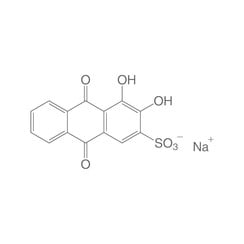You have no items in your shopping cart
Alizarin red S
Alizarin Red S (also known as C.I. Mordant Red 3, Alizarin Carmine and C.I 58005. It is a water-soluble sodium salt of Alizarin sulfonic acid with a chemical formula of C
14H7NaO7S. Alizarin Red S was discovered in 1871 by Graebe and Libermann. In the field of histology, alizarin Red S is used to stain calcium deposits in tissues, and in geology to stain and differentiate carbonate minerals.
Alizarin Red S is used in histology and histopathology to stain or locate calcium deposits in tissues. In the presence of calcium, Alizarin Red S binds to the calcium to form a Lake pigment that is orange to red in color. Whole specimens can be stained with Alizarin Red S to reveal bone distribution, especially in developing embryos. In living corals, alizarin Red S has been used to mark diurnal growth layers. In geology, Alizarin Red S is used on thin parts and polished surfaces to identify carbonate minerals that discolor at different rates.

